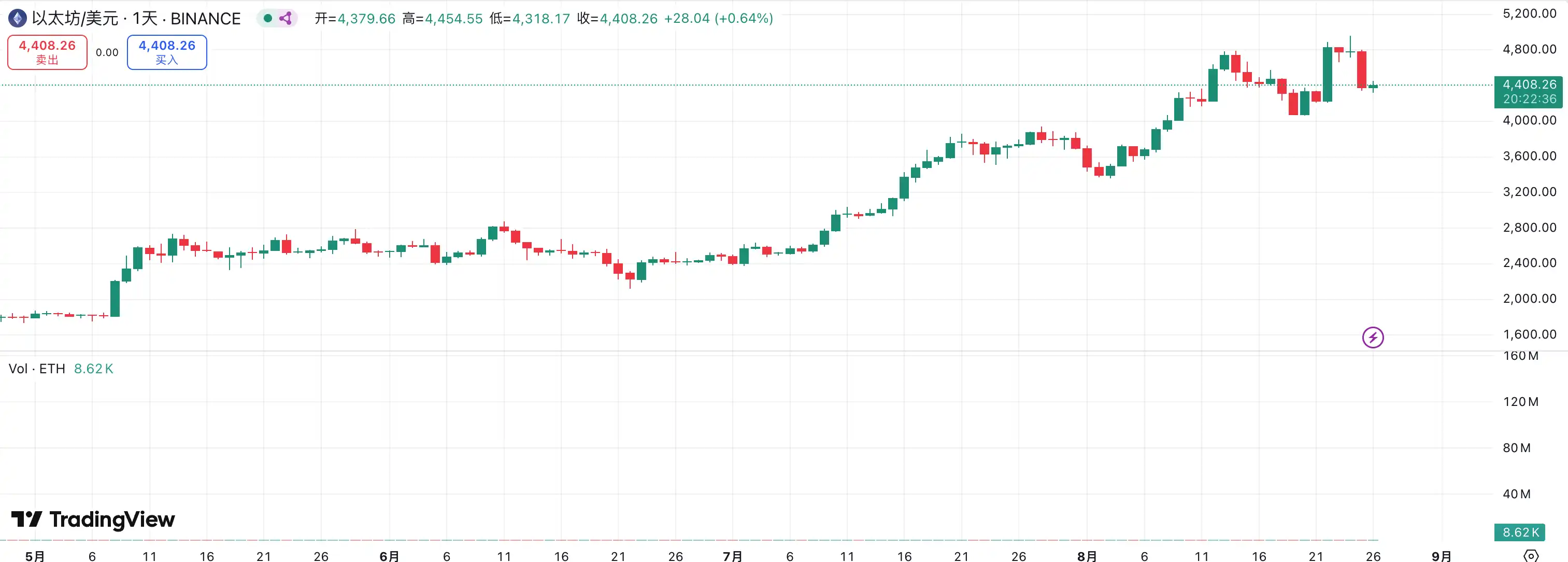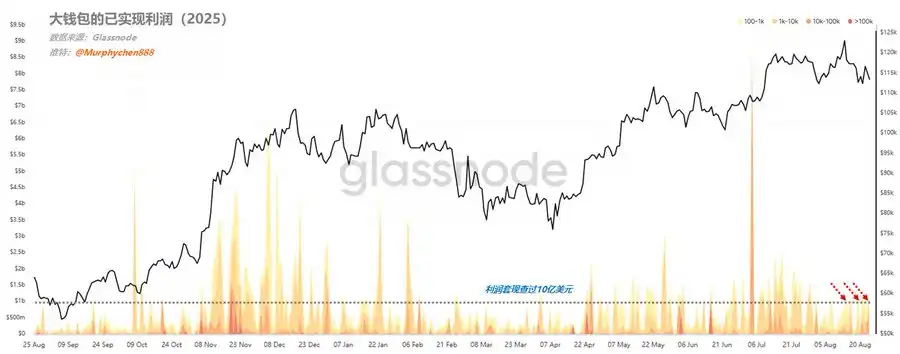At the Jackson Hole Global Central Bank Annual Meeting, Federal Reserve Chairman Powell released clear dovish signals. The market reacted swiftly: ETH briefly broke through $5000, setting a new historical high, and the S&P 500 ended its previous five-day decline, rebounding 1.5% in a single day, just a step away from its historical peak.
However, this brief euphoria was soon overshadowed by new concerns. Uncertainties such as the U.S. "recession theory," the PCE price index, and Nvidia's earnings report made the high market sentiment sensitive again, leading to a rapid cooling of risk appetite, and the trend shifted back to a correction. Currently, BTC has fallen below $110,000, and ETH has dropped 8% in a single day to $4400.

Next, Rhythm BlockBeats compiled traders' views on the upcoming market situation to provide some directional references for trading this week.
@0xENAS
I believe we are in the "final round" of this bull market cycle that started in January 2023. Such phase-based markets often do not last long, probably just a month or two. Now, almost all marginal buyers globally have entered the market, and the incremental funds in the crypto market have been fully absorbed, with both BTC and ETH reaching historical highs.
The mid-to-long-term target I previously set for ETH/BTC at 0.04 has been reached, which for me means that the main trading opportunities for ETH have basically ended.
This also determines my strategy shift—I will no longer take aggressive positions. Moving forward, my focus will shift from "accumulating capital" to "preserving capital." I might miss out on the potential crazy market that could follow, but that's okay because it doesn't align with my trading system.
This does not mean I have completely exited or turned bearish. On the contrary, I still maintain long positions, but my exposure has significantly decreased. I will continue to monitor DAT's mNAV as a core indicator; when this cycle ends, most DAT's mNAV will fall below 1.
@CryptoHayes
I believe the market at the end of the year is likely to be higher than it is now. As long as you are not leveraged, there is no need to worry too much about short-term fluctuations—even if it drops 15%-20% this week, if you have spare cash, it could be a good opportunity to add to your position. I can almost guarantee that before the end of the year, we will see "money printing," with Bitcoin possibly surging to $250,000 and ETH potentially breaking $10,000. Once ETH surpasses its historical high, the upward space will be completely opened, and I even think that $10,000 to $20,000 is a reasonable range.
The core of this logic lies in: digital asset treasury companies are continuously raising funds. As long as the asset prices they buy keep hitting new highs, the fundraising process will become easier, and funds will continuously push prices up, creating positive feedback. There are two key variables behind this—how much these companies can raise and how much liquidity the government will release. I am not one of those who rigidly adhere to the "four-year Bitcoin cycle"; the length of this market cycle largely depends on how capital and policy interact.
Currently, the Trump administration has not fully entered "money printing mode"; they are more like testing the waters—throwing out various ideas to see which can actually be implemented while signaling "we want to heat up the economy." Once the Federal Reserve Chairman and board member candidates are settled, such as whether Trump can replace Powell and arrange his own people, the rhythm will become truly clear, which is expected to take until mid-next year.
Once the personnel layout is complete, from mid-2026 until the end of Trump's term, it will be the craziest easing phase. Because without money printing, it is impossible to win elections. The Democrats will print, and the Republicans will have to print too; everyone will use liquidity to please their supporters and interest groups.
As for treasury companies, some may be acquired due to valuation discounts or directly liquidate their assets. Leading projects will passively absorb capital and become winners, while laggards will be eliminated. But this real "industry reshuffle" may still take some time to arrive.
Related reading: "Arthur Hayes' Latest Interview: Autumn Correction, Long-term ETH Target of $10,000 to $20,000"
@rickawsb
Bitcoin and Ethereum saw a significant correction today, with various reasons cited.
Some say it's due to trading platforms dumping, others say it's because whales are fleeing, some speculate Nvidia's earnings report this week may not meet expectations, and others mention Trump saying the cards he holds could "destroy" the Chinese economy, along with new reports from Moody's and some economists stating that the U.S. is on the brink of recession.
Other reasons are unlikely to cause long-term widespread impacts; the recession theory can be discussed further, as economic signals are numerous and complex.
Personally, I believe traditional economists may once again overlook the "non-traditional" key factor reshaping the economic landscape: the AI revolution. If we must talk about recession pressures, a more appropriate description might be: the U.S. economy is in a unique period shaped by cyclical pressures (as indicated by the LEI leading economic index) and structural new dynamics (as indicated by the AI revolution). The risk of recession does exist and cannot be ignored, but the accelerated development of AI is the decisive factor for the economy. The current situation resembles a "gear-shifting" phase in an economic structural transformation rather than a simple cyclical recession.
According to research estimates from major institutions, even under pessimistic expectations, generative AI could trigger a "massive labor productivity boom" in the next one to three years, potentially adding trillions of dollars to global GDP. The massive investments in AI explain why, despite numerous warning signals, hard economic data remains resilient. Similarly, the viewpoint of a stock market crash largely does not consider the AI factor.
The conclusion is: there will be growing pains, there will be corrections in a bull market, but there will be no recession, the bear market has not arrived, and the bull is still here!
@Murphychen888
My definition of a bear market is: the main participants in the market have completely lost confidence in the future. This can be seen from the behavior of large holders.
If we were to mark a point, in November 2021, large holders in the market (holding 100-100,000 BTC) frequently and continuously realized profits, with a scale exceeding $2 billion. Now, even though BTC has reached a historical high of $120,000, the maximum profit realization scale for large holders is still less than $1 billion. This is completely different from the second peak period in 2021.
In terms of chip structure, when the price reached $65,000 in 2021, a large number of cheap chips were concentrated in the $6,000-$10,000 range, allowing for significant profit realization even if prices fell.

In contrast, in 2025, a large number of chips are concentrated in the $90,000-$110,000 and $113,000-$118,000 ranges. If prices fall below the cost range, these chips will not only have no profit but will also incur significant losses. Those holding these chips include institutions that bought through ETFs and Wall Street capital.

So, will the technical top divergence and high-level death cross in the K-line necessarily lead to a long-term bear market like in 2021 after a double top? Should we not consider changes in chip structure, whale behavior, macro easing, and other objective conditions? If we say we are entering a "phase of weakness," I agree, but I do not agree with a rigid and mechanical approach, as it seems to sell anxiety.
@Vida_BWE
I just feel that the bull market progress bar has loaded 80%, and those who continuously invest with a long-term investment goal can stop now. Buying spot now has no cost-effectiveness; those who already have a full bag should switch to a mode of only reducing positions.
Assuming a six-month investment cycle:
Plan A: Buy spot; the market total cap may continue to rise by 30%, but you also have to bear the risk of a 30%+ correction.
Plan B: U-based arbitrage, which can yield 20% with 0% drawdown.
For large fund players who "manage their own money," a portfolio growth of 30% with 0% drawdown over the year is more cost-effective than a growth of 50% with a maximum drawdown of 20%.
For large fund players like strategy and sbet who "manage other people's money," it is the opposite; they are not afraid of losses since they are not losing their own money, and they earn from AUM, so they do not care much about drawdowns; they just buy without looking at prices.
@fundstrat
BMNR CEO Tom Lee, citing Bloomberg analysts, stated that ETH is expected to bottom out in the next few hours. The odds at the current price are quite good; if it falls below the lowest point of $4067 since August 18, it would indicate a short-term bearish outlook. Ideally, ETH would bottom out around $4300 in the next 12 hours, then rebound and break the previous high of $5100, pushing towards $5400.
免责声明:本文章仅代表作者个人观点,不代表本平台的立场和观点。本文章仅供信息分享,不构成对任何人的任何投资建议。用户与作者之间的任何争议,与本平台无关。如网页中刊载的文章或图片涉及侵权,请提供相关的权利证明和身份证明发送邮件到support@aicoin.com,本平台相关工作人员将会进行核查。




